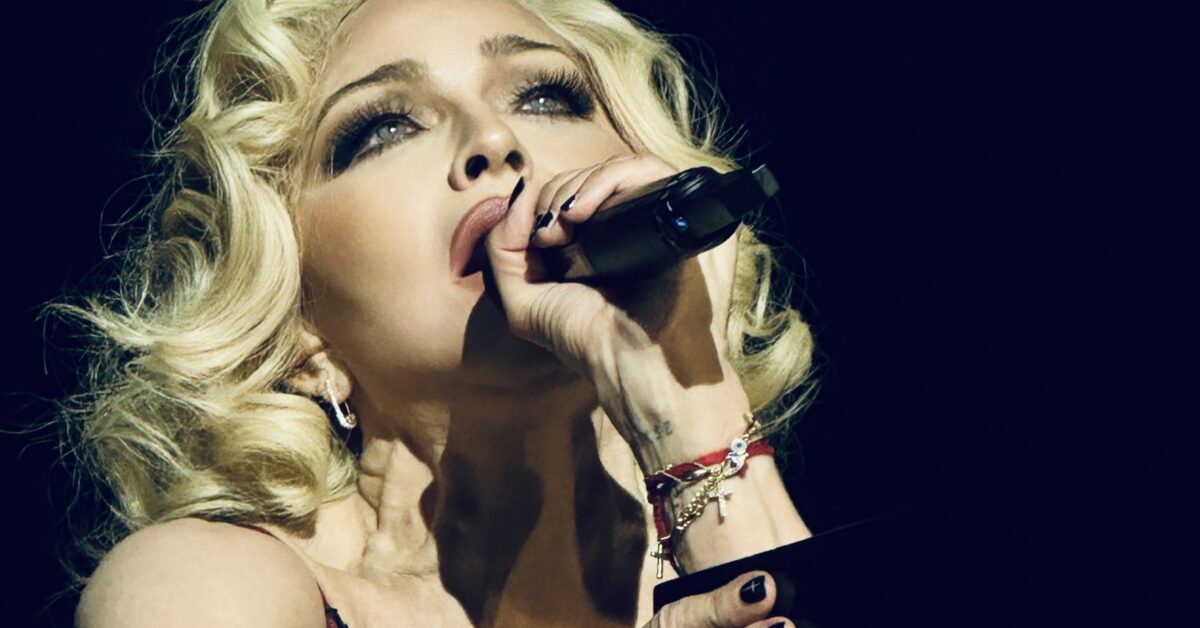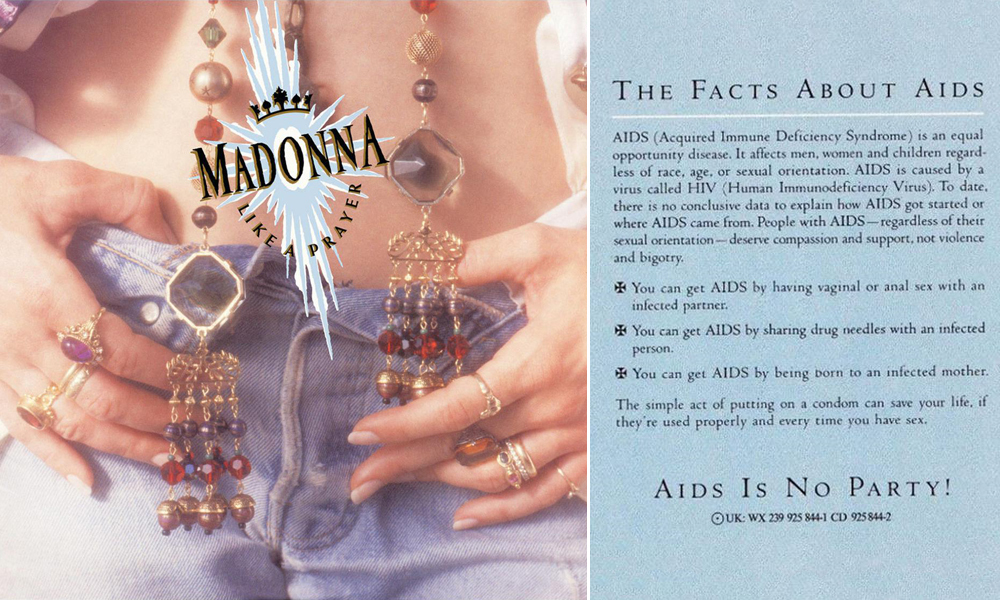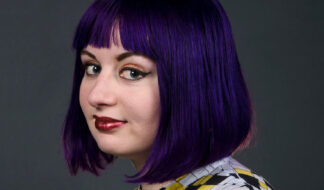Madonna Was an AIDS Advocate Before the President Would Even Say the Word
A timeline of the pop icon’s outspoken support for the community

Find me a better queer ally than Madonna. Go on, I dare you. After all, there are precious few people who have risked as much as Madonna did when she spoke out about AIDS and visibly supported the gay community at a time when literally touching a gay person was considered a frightening prospect by much of the world’s population.
Madonna took off for the excitement of New York City in the late ‘70s as a young adult, but not before she spent time as a dance major at the University of Michigan after graduating from Rochester Adams High School in 1975 as a straight-A student. As a teen, she spent time at queer nightclub Menjo's, no doubt finding a home among Detroit’s more colorful characters. Madonna, who returns to Detroit for a show at Little Caesars Arena on Jan. 15 , has been an outspoken LGBTQ+ ally ever since.
Before President Reagan had even acknowledged that AIDS existed in 1985, Madonna had been advocating on behalf of her friends and loved ones for compassion, funding and education. It was a bold choice in an era that was anything but kind and welcoming to the LGBTQ+ community, especially gay men. These highlights from her long career are just a few examples of how the pop queen has always advocated for AIDS patients and their loved ones.
1985: Madonna Appears in AIDS 'SNL' Sketch
In 1985, Madonna confronted the AIDS stigma through a skit on “Saturday Night Live” titled "Pinklisting." Channeling Joan Collins with a dark wig and a clipped British accent, Madonna played a TV actress apprehensive about scenes with a co-star due to AIDS fears. In an era where AIDS was deemed a death sentence, Madonna's bold approach, less than a month after Rock Hudson's death, brought a crucial discourse into millions of homes.
1986: Madonna Loses Her Best Friend to AIDS
Before she was famous, Madonna shared a small apartment in New York City’s Lower East Side with her best friend Martin Burgoyne, who would later draw the cover image of her 1983 “Burning Up” EP and appear in the video for “Material Girl.” Burgoyne was one of the first people Madonna knew who was diagnosed with AIDS. She cared for him throughout his illness and paid for his medical expenses at St. Vincent’s Hospital as well as a nearby apartment for him in Greenwich Village. Madonna was by Burgoyne’s side when he died at 24 years old in 1986. Her 1992 song “In This Life," from the album “Erotica," is about their relationship.
In a since-deleted Instagram post in 2018, Madonna posted a tribute to her friend. “In my apartment on the L.E.S. [Lower East Side] where I lived with my best friend Martin Burgoyne who died of AIDS,” she wrote alongside a photo of the two in better days. “I held his hand as his spirit left his body,” she continued “He was so beautiful and talented and full of life like so many others. In those days it ravaged people and took so many lives in the blink of an eye. We have come a long way but we still have NO cure! Let’s pray for this and more tolerance in the world.”
1989: AIDS Pamphlets in Copies of 'Like a Prayer'
When Madonna released her fourth studio album “Like a Prayer” in 1989, many critics considered it a departure from her pop roots. Here, she dove headfirst into topics like domestic violence, women’s rights, spirituality and childhood trauma with a new level of vulnerability. She also took advantage of her superstardom to deliver a message about AIDS directly to a captive audience by including a safe sex pamphlet with facts about the disease inside every album.

The card insert called AIDS “an equal opportunity disease” and stressed that “people with AIDS, regardless of their sexual orientation, deserve compassion and support, not violence and bigotry.” The message may seem tame by today’s standards, but remember, this was at a time when many Americans believed AIDS was a curse from God against the gay community.
1990: Tribute to Keith Haring
Madonna’s close friend, the artist Keith Haring, died from AIDS in early 1990. The singer spoke about him frequently, never shying away from Haring’s diagnosis. Haring was outspoken about his status and she made it a point to honor his courage. On the last leg of her “Blond Ambition” tour in 1990, Madonna spoke about Haring from the stage. “Now, you probably know Keith Haring as an artist, but I know him as a man who had the courage to tell the truth,” she began. “The truth is he was gay. The truth is he had AIDS, and he said so to anybody who would listen.”
“In memory of Keith,” she continued, “Let’s tell ourselves the truth. Let’s tell it to each other. Let’s face it together. The truth is AIDS is our enemy. Prejudice is our enemy. AIDS does not know if we are gay or if we are straight. It has no sexual preference.”
Madonna posted a tribute to Haring in 2018 on Twitter alongside a vintage image with the artist. “He was a big AIDS activist when everyone was calling it GAY cancer,” she wrote. “I was with him the day he died of AIDS. He said what hurt him the most was how people did not want to touch door knobs after he touched them.”
1990: Christopher Flynn Dies
Madonna’s ballet teacher and mentor from Michigan, Christopher Flynn, also died from AIDS in 1990. She told Interview magazine in 2010 that “Growing up in Michigan, I didn’t really know what a gay man was. [Christopher] was the first man — the first human being — who made me feel good about myself and special. He was the first person who told me that I was beautiful or that I had something to offer the world, and he encouraged me to believe in my dreams, to go to New York. He was such an important person in my life. He died of AIDS, but he went blind toward the end of his life.”
1991: Madonna Becomes the Subject of HIV/AIDS Rumor
In 1991, Madonna was the target of rumors that she was HIV-positive, just a year after she lost both Haring and Flynn. Entertainment Weekly (EW) speculated that the rumors started when Christopher Anderson, author of “Madonna: Unauthorized,” which came out earlier in 1991, published teasers that his book would reveal “the tragic reasons for Madonna’s very personal campaign to find a cure for AIDS.”
In fact, the book doesn’t indicate Madonna had ever tested positive. The teasers, he said, referred to the people she’d known and loved who had succumbed to AIDS. “Given her penchant for scandal, she’s a lightning rod for this sort of untruth,” Anderson told EW. Anderson seemed to benefit from Madonna’s lighting rod quality, honing in on claims that Madonna once “trolled” New York City’s East Village for young Hispanic men in the early ‘80s, writing in his book, “It was anybody’s guess whether any of them were carrying the AIDS virus or had been intravenous drug users.”
At the time, Madonna’s publicist Liz Rosenberg told EW that Madonna was “angry and upset.” “She can’t understand it,” Rosenberg told the outlet, “but feels there may be some kind of strange conspiracy behind it.” EW reported that some members of the gay community felt the root of the rumors was ultimately rooted in AIDS phobia. “I think this particular rumor is entirely AIDS-phobic and homophobic,” Richard Rouilard, editor of The Advocate at the time, told EW.
“It’s a backlash at Madonna for being so actively involved in AIDS and championing gay people, both in her movies and in her interviews. This is a straight backlash,” said the late Howard Bragman, then-president of Bragman & Co., a Los Angeles publicity firm that represents AIDS organizations as well as celebrities. Bragman said such rumors can be ”very, very destructive. They can discourage people who are truly HIV-positive from coming forth, and that’s a tragedy.”
2023: Celebration Tour AIDS Memorial
Madonna's emotionally charged rendition of “Live to Tell,” dedicated to HIV/AIDS victims, has stood as the poignant centerpiece of the Celebration Tour since its initiation in London in October.
The tribute unfolds within the concert set, commencing with the energetic “Holiday,” a nostalgic nod to 1983 at New York's iconic Paradise Garage, a pre-fame haunt for Madonna. In the middle of a group of frenetic dancers, a solitary figure collapses, paving the way for the somber transition to “In This Life” and the powerful “Live to Tell.”
Madonna's connection to the HIV/AIDS epidemic becomes apparent, rooted in her immersion in New York's queer club culture in 1978 and before that, at places like Menjo’s in Detroit. A 2018 Daily Beast article recounts a fun bit of local lore related to Madonna’s imprint on the long-standing queer mainstay. “Before she went to New York and got famous, this was her hangout,” Menjo’s manager Tim McKee-Zazo told the outlet. “Her period of coming here was the mid to late ’70s, but then she was barred from coming,” he said.

During the Celebration Tour, Madonna honors her early club days and close connections to the gay men in her life as the “Live to Tell” tribute integrates deeply personal elements, featuring video screens with faces that represent significant losses: Burgoyne, Flynn and Haring are all featured here before the screens expand to include numerous other victims, creating a universal and profoundly moving moment.
Say what you will about Madonna, but she has been unwavering in her full-throated support for the physical and emotional well-being of HIV/AIDS patients for her entire adult life. At a time when even the president of the United States refused to acknowledge the crisis was killing thousands of young men in this country, Madonna was steadfast in her defiance, knowing full well that her support had cost her career opportunities along the way.
When she takes the stage in Detroit, audience members who remember what it was like to live through the AIDS crisis will feel some catharsis and maybe a little healing, too. Forty years later, Madonna is still pouring love into the queer community and proving she will never forget what happened to the gay community in a country that should have known better.










